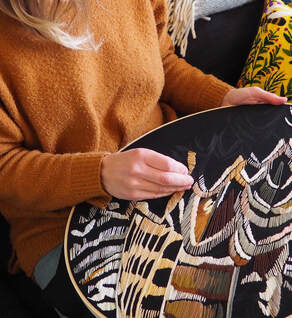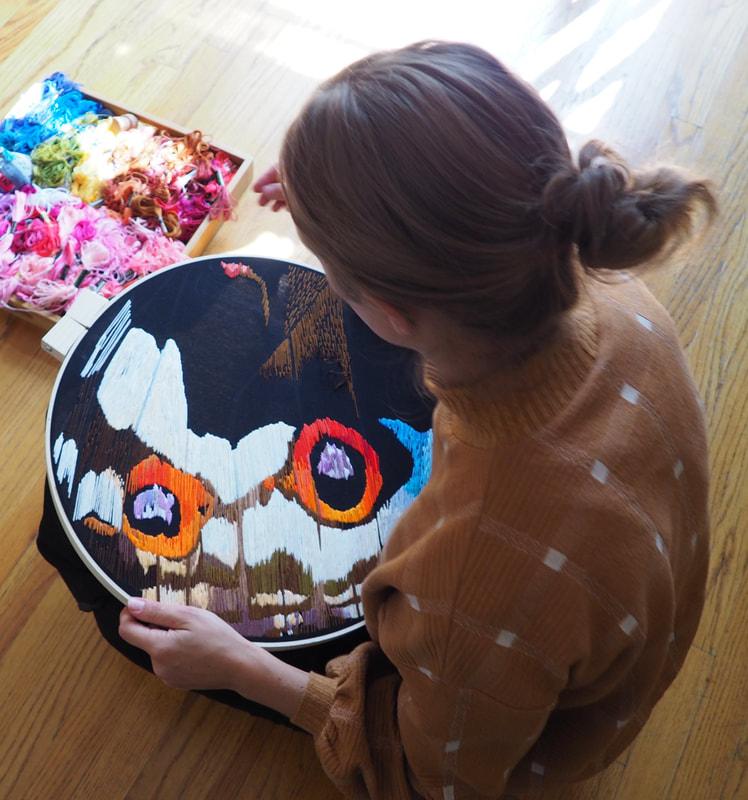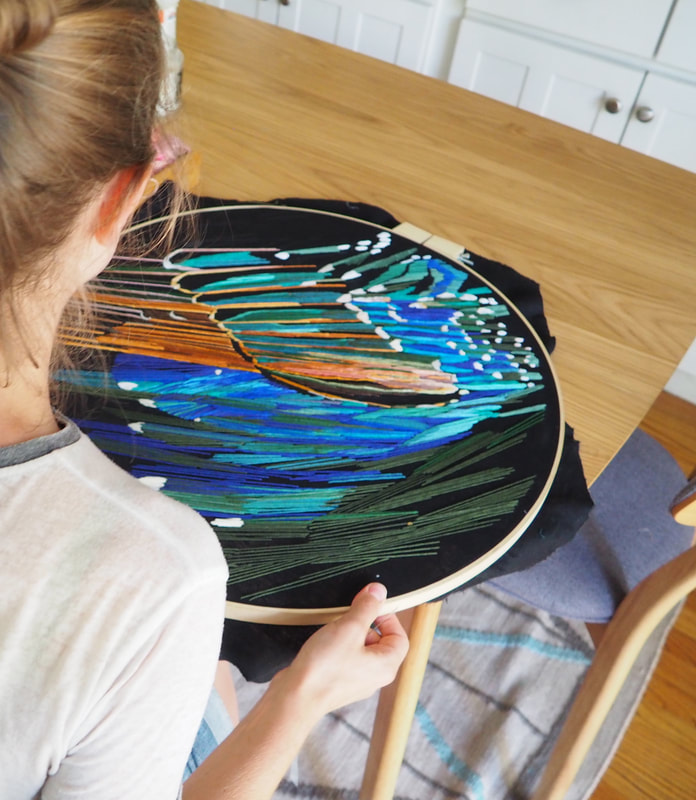
I'm all about the process being just as important as what you end up with. I research the folklore and symbolism of nature and natural things, following my nose for whatever interests me. Once I select an image, I sketch an outline and transfer it to fabric before stitching, choosing colors and adjusting the design as I go. Most of my work is inspired by photographs from nature. I especially love macro photography and the process of zooming in on the tiniest of details and amplifying them. I often see echos in the tiniest and hugest of things, loving how some of the microscopic details in insects and plants look like aerial views of landscapes. Each design involves a lot of time, and as any embroiderer knows, all good things take time. Embroidery is great for zoning into a project and relaxing, letting it take over for a while. Some of my favorite things about the process are...
Choosing Fabric and Floss
This is always such a fun part of the process, I love perusing colours of fabric and narrowing designs down to a background color that will bring out their dapperness best. I tend to use DMC threads and needles, as they are tried and tested to be great quality, although I dabble in other threads at times. I especially love satin thread, where it has a shine to it, as it really brings out the light in some of the embroideries. I choose colors as I stitch, which helps me bring out the more subtle colors and shades like painting.
Choosing a Hoop Size
This can take time, depending on how much energy I have, the bigger the hoop, the longer the stitching takes and the more energy and enthusiasm for a design is needed. I love taking on ever bigger hoops, but also love the craft and detail involved in tiny hoops, my favorites being 3 inches. I always use wooden or bamboo hoops, as I'm trying to live as plastic free as possible.
Transferring
I'm still figuring out the best ways to do this. I tend to either print my sketches onto fabric after scanning them, or I draw directly onto the fabric. For black fabric I use a white pencil, which helps me to define the mini details and keep an eye on the design as a whole. A white pencil also allows me to correct my sketch when it goes wonky.
Stitching
This is my favorite part. There is a lovely rhythm to the ins and outs of threading and learning new stitches. One of my favorites currently is the french knot, so simple and effective for dots! I am still experimenting with it, so it doesn't always work out :) I start out stitching like painting just going with the flow, while keeping an eye on the photographs or designs I'm using as inspiration. I am a big believer of art as part of relaxing, healing and centering. Here is a great article about the healing aspects of sewing...
https://www.theguardian.com/lifeandstyle/2019/feb/23/the-calming-effects-of-sewing-can-help-people-express-and-calm-themselves
As an art therapist my young clients would often gravitate towards stitching materials and make some amazing work spontaneously, often expressing a need for comfort, feeling held together and understanding the layers in their experiences. Stitching and sewing always seems somehow to relate to love, comfort and security.
Developing Kits
I am excited about making kits that others can enjoy, sharing the love of learning how to stitch little creatures and plants. Often people will have some experience of stitching as a kid. I often feel that art practice becomes harder as jobs and life takes over, but I think having a kit that you can pick up whenever you have a few minutes is so soothing and helps to center people when feeling stressed and busy or just as a Sunday afternoon activity with a cup of tea. I start out with my own embroideries, using them as an outline for a kit. I then simplify them using some basic computer programs to create diagrams that are easy to follow, basing a system around colors like painting with numbers. I trace my steps back to starting an embroidery paying attention to every part of the process. I make each kit from scratch, even the envelopes, and get at least a couple people to test each design before putting it out there for others to enjoy for maximum makeability and stitching joy!
Choosing Fabric and Floss
This is always such a fun part of the process, I love perusing colours of fabric and narrowing designs down to a background color that will bring out their dapperness best. I tend to use DMC threads and needles, as they are tried and tested to be great quality, although I dabble in other threads at times. I especially love satin thread, where it has a shine to it, as it really brings out the light in some of the embroideries. I choose colors as I stitch, which helps me bring out the more subtle colors and shades like painting.
Choosing a Hoop Size
This can take time, depending on how much energy I have, the bigger the hoop, the longer the stitching takes and the more energy and enthusiasm for a design is needed. I love taking on ever bigger hoops, but also love the craft and detail involved in tiny hoops, my favorites being 3 inches. I always use wooden or bamboo hoops, as I'm trying to live as plastic free as possible.
Transferring
I'm still figuring out the best ways to do this. I tend to either print my sketches onto fabric after scanning them, or I draw directly onto the fabric. For black fabric I use a white pencil, which helps me to define the mini details and keep an eye on the design as a whole. A white pencil also allows me to correct my sketch when it goes wonky.
Stitching
This is my favorite part. There is a lovely rhythm to the ins and outs of threading and learning new stitches. One of my favorites currently is the french knot, so simple and effective for dots! I am still experimenting with it, so it doesn't always work out :) I start out stitching like painting just going with the flow, while keeping an eye on the photographs or designs I'm using as inspiration. I am a big believer of art as part of relaxing, healing and centering. Here is a great article about the healing aspects of sewing...
https://www.theguardian.com/lifeandstyle/2019/feb/23/the-calming-effects-of-sewing-can-help-people-express-and-calm-themselves
As an art therapist my young clients would often gravitate towards stitching materials and make some amazing work spontaneously, often expressing a need for comfort, feeling held together and understanding the layers in their experiences. Stitching and sewing always seems somehow to relate to love, comfort and security.
Developing Kits
I am excited about making kits that others can enjoy, sharing the love of learning how to stitch little creatures and plants. Often people will have some experience of stitching as a kid. I often feel that art practice becomes harder as jobs and life takes over, but I think having a kit that you can pick up whenever you have a few minutes is so soothing and helps to center people when feeling stressed and busy or just as a Sunday afternoon activity with a cup of tea. I start out with my own embroideries, using them as an outline for a kit. I then simplify them using some basic computer programs to create diagrams that are easy to follow, basing a system around colors like painting with numbers. I trace my steps back to starting an embroidery paying attention to every part of the process. I make each kit from scratch, even the envelopes, and get at least a couple people to test each design before putting it out there for others to enjoy for maximum makeability and stitching joy!



